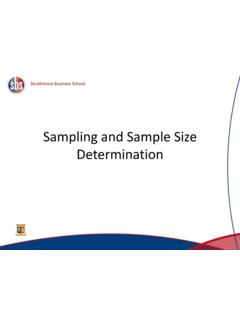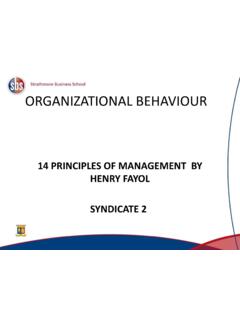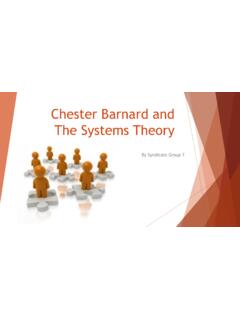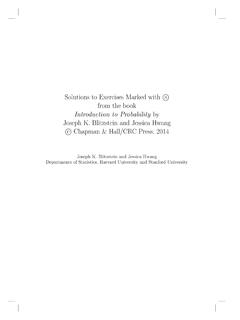Transcription of Examples of Continuous Probability Distributions
1 Examples of Continuous Probability Distributions :The normal and standard normalThe Normal DistributionXf(X)Changing shifts the distribution left or increases or decreases the Normal Distribution:as mathematical function (pdf)2)(2121)( =xexfNote constants: = is a bell shaped curve with different centers and spreads depending on and The Normal PDFIt s a Probability function, so no matter what the values of and , must integrate to 1!1212)(21= + dxex Normal distribution is defined by its mean and standard dev. E(X)= = Var(X)= 2 =Standard Deviation(X)= dxexx + 2)(2121 2)(212)21(2 + dxexx**The beauty of the normal curve: No matter what and are, the area between - and + is about 68%; the area between -2 and +2 is about 95%; and the area between -3 and +3 is about Almost all values fall within 3 standard deviations.
2 Rule68% of the data95% of the of the Rulein Math )(2122)(21)(21222= = = + + + dxedxedxexxxHow good is rule for real data?Check some example data:The mean of the weight of the women = standard deviation (SD) = 8 0 9 0 10 0 1 10 1 20 1 30 1 40 15 0 16 0 0 5 1 0 1 5 2 0 2 5 P e r c e n t P OU N DS of 120 = .68x120 = ~ 82 runnersIn fact, 79 runners fall within 1-SD ( lbs) of the mean. 8 0 9 0 10 0 1 10 1 20 1 30 1 40 15 0 16 0 0 5 1 0 1 5 2 0 2 5 P e r c e n t P OU N DS of 120 = .95 x 120 = ~ 114 runnersIn fact, 115 runners fall within 2-SD s of the 8 0 9 0 10 0 1 10 1 20 1 30 1 40 15 0 16 0 0 5 1 0 1 5 2 0 2 5 P e r c e n t P OU N DS of 120 = .997 x 120 = runnersIn fact, all 120 runners fall within 3-SD s of the Suppose SAT scores roughly follows a normal distribution in the population of college-bound students (with range restricted to 200-800), and the average math SAT is 500 with a standard deviation of 50, then: 68% of students will have scores between 450 and 550 95% will be between 400 and 600 will be between 350 and 650 Example What if you wanted to know the math SAT score corresponding to the 90thpercentile (=90% of students are lower)?
3 P(X Q) = .90 )50(1200)50500(212= Qxdxe Solve for Q?..Yikes!The Standard Normal (Z): Universal Currency The formula for the standardized normal Probability density function is:22)(21)10(21212)1(1)(ZZeeZp = = The Standard Normal Distribution (Z) All normal Distributions can be converted into the standard normal curve by subtracting the mean and dividing by the standard deviation: =XZSomebody calculated all the integrals for the standard normal and put them in a table! So we never have to integrate! Even better, computers now do all the X and Z ( = 100, = 50)( = 0, = 1)Example For example: What s the Probability of getting a math SAT score of 575 or less, =500 and =50? =Z , A score of 575 is standard deviations above the mean = )50500(2122212)50(1)575(dzedxeXPZx Yikes!
4 But to look up Z= in standard normal chart (or enter into SAS) no problem! = .9332 Practice problemIf birth weights in a population are normally distributed with a mean of 109 oz and a standard deviation of 13 oz, a. What is the chance of obtaining a birth weight of 141 ozor heavierwhen sampling birth records at random?b. What is the chance of obtaining a birth weight of 120 or lighter?Answera. What is the chance of obtaining a birth weight of 141 oz or heavierwhen sampling birth records at random? =ZFrom the chart or SAS Z of corresponds to a right tail (greater than) area of: P(Z ) = 1-(.9931)= .0069 or .69 % Answerb. What is the chance of obtaining a birth weight of 120 or lighter?From the chart or SAS Z of .85 corresponds to a left tail area of:P(Z .85) =.
5 8023= =ZLooking up probabilities in the standard normal tableWhat is the area to the left of Z= in a standard normal curve?Z= is probabilities in SASdata _null_;the Area=probnorm( );put the Area;run; if you wanted to go the other direction ( , from the area to the Z score (called the so-called Probit function data _null_;the ZValue=probit(.93);put the ZValue;run; probnorm(Z) function gives you the Probability from negative infinity to Z (here ) in a standard normal probit(p) function gives you the Z-value that corresponds to a left-tail area of p (here .93) from a standard normal curve. The probit function is also known as the inverse standard normal function: the inverse (area)= Z: gives the Z-value that goes with the Probability you want For example, recall SAT math scores example.))
6 What s the score that corresponds to the 90thpercentile? In Table, find the Z-value that corresponds to area of .90 Z= use SASdata _null_;theZValue=probit(.90);put theZValue;run; Z= , convert back to raw SAT score = X 500 = (50) X= (50) + 500 = 564 ( standard deviations above the mean!)`50500 XAre my data normal ? Not all Continuous random variables are normally distributed!! It is important to evaluate how well the data are approximated by a normal distributionAre my data normally distributed? at the histogram! Does it appear bell shaped? descriptive summary measures are mean, median, and mode similar? 2/3 of observations lie within 1 std dev of the mean? Do 95% of observations lie within 2 std dev of the mean? at a normal Probability plot is it approximately linear?
7 Tests of normality (such as Kolmogorov-Smirnov). But, be cautious, highly influenced by sample size!Data from our = 6 Mean = = 0SD = = 0 to 24 (= )Data from our = 5 Mean = = noneSD = = 2 to 9 (~ 4 )Data from our = 3 Mean = = 3SD = = 0 to 12 (~ 5 )Data from our = 7:00 Mean = 7:04 Mode = 7:00SD = :55 Range = 5:30 to 9:00(~4 )Data from our +/- = from our +/- 2* =0 from our +/- 3* =0 from our +/- = from our +/- 2* = from our +/- 3* =0 10010 Data from our +/- from our +/- 2* from our +/- 3* from our :04+/- 0:55 =6:09 7:596:097:59 Data from our :04+/- 2*0:55 =5:14 8:545:148:54 Data from our :04+/- 2*0:55 =4:19 9:494:199:49 The Normal Probability Plot Normal Probability plot Order the data.
8 Find corresponding standardized normal quantile values: Plot the observed data values against normal quantile values. Evaluate the plot for evidence of tail-left particular a toscorrespondthat value Z thegives which function,probit theis where)1ni( quantile +=thiNormal Probability plot !(concave up)Normal Probability plot love of right-skewed or left-skewed, but big gap at 6. Norm prob. plot !(concave up)Norm prob. plot Wake up timeClosest to a straight tests for normality Results: Coffee: Strong evidence of non-normality (p<.01) Writing love: Moderate evidence of non-normality (p=.01) Exercise: Weak to no evidence of non-normality (p>.10) Wakeup time: No evidence of non-normality (p>.25)Normal approximation to the binomialWhen you have a binomial distribution where nis large and pis middle-of-the road (not too small, not too big, closer to.)
9 5), then the binomial starts to look like a normal distribution in fact, this doesn t even take a particularly large n Recall: What is the Probability of being a smoker among a group of cases with lung cancer is .6, what s the Probability that in a group of 8 cases you have less than 2 smokers? Normal approximation to the binomialWhen you have a binomial distribution where n is large and p isn t too small (rule of thumb: mean>5), then the binomial starts to look like a normal distribution Recall: smoking to have a normal shape even with fairly small n. You can imagine that if ngot larger, the bars would get thinner and thinner and this would look more and more like a Continuous function, with a bell curve shape. Here np= approximation to is the Probability of fewer than 2 smokers?
10 Normal approximation Probability : = = ) (2 = = ZExact binomial Probability (from before) = .00065 + .008 = .00865P(Z<2)=.022A little off, but in the right we could also use the value to the left of (as we really wanted to know less than but not including 2; called the continuity correction ).. ) ( = = ZP(Z ) =.0069A fairly good approximation of the exact Probability , . problem1. You are performing a cohort study. If the Probability of developing disease in the exposed group is .25 for the study duration, then if you sample (randomly) 500 exposed people, What s the Probability that at most120 people develop the disease?AnswerP(Z< )= . = =Z50005000)75(.)25(. 49915001)75(.)25(. 49825002)75(.)25(. 380120500120)75(.)25(. +++..By hand (yikes!):P(X 120) = P(X=0) + P(X=1) + P(X=2) + P(X=3) + P(X=4)+.






